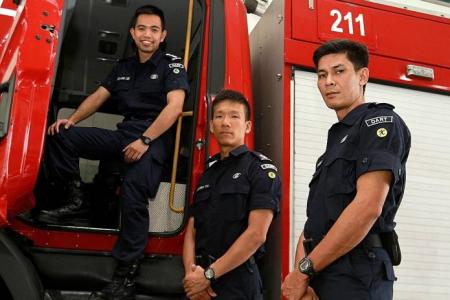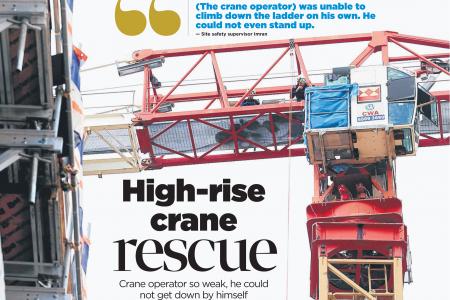Elite Dart rescuers recount crane operator rescue
Elite Dart rescuers recount how they managed to bring a sick tower crane operator down from his perch 40m up
They are all veterans of the Singapore Civil Defence Force's (SCDF) elite Disaster Assistance and Rescue Team (Dart).
Between them, Captain Leonard Lee, Warrant Officer 1 Andrew Tai and Sergeant Fadly Ismail have a total of 20 years' experience. Four other colleagues participated in the rescue, too.
So it was a rather straightforward job to rescue a crane operator who was stuck atop his 40m-tall tower crane, almost 13 storeys high, and had suddenly felt unwell at a construction site in Whampoa East on Tuesday morning. The 39-year-old man was so weak, he could not make his own way down.
But when officers reached the top of the crane, they were taken aback by the small space they had to work in.
Said Capt Lee, the platoon commander: "We found the crane operator sitting on a very small and cramped platform.
"It was around 1.5m by 1.5m, and there were four other SCDF officers (who were not part of Dart) on it as well."
The crane operator was nauseous and complained of numbness in his legs, he added.
Section commander WO1 Tai said: "He kept groaning in Mandarin, 'I cannot take it already, I cannot take it already!'"
Due to his obvious discomfort, they decided to choose the most direct way down - rappelling.
They sprung into action immediately.
WO1 Tai began securing their safety lines on the boom of the crane, while Capt Lee attached the harness to the crane operator.
WO1 Tai said: "We made sure there was a clear path down without any obstacles."
Sgt Fadly, a Dart rescue specialist, was then rigged onto the safety line and lowered himself to receive the sick crane operator.
Three other officers were on the ground, while another stationed himself midway up the crane ladder.
Sgt Fadly said: "It was quite high up, but we are used to it, so it was nothing to us."
But what became a considerable challenge for the Dart rescuers was the weight of the crane operator.
Capt Lee, who estimated the crane operator weighed about 80kg, noted: "We really struggled to move him, especially on the cramped platform."
With the combined effort of the other SCDF officerson the platform, they managed to secure the crane operator's harness and move him over the railing of the platform so that Sgt Fadly could start rappelling down.
Meanwhile, Dart rescue specialist Staff Sergeant Razif, who was stationed halfway up the crane ladder, made sure the safety lines did not get tangled or swing too much, ensuring a smooth descent.
Things did not go smoothly though.
Midway through the descent, the crane operator began groaning again.
Sgt Fadly said: "He wanted to vomit, so I replied, 'Just vomit on my pants, it's okay.' Then he really vomited on my pants."
But he is not complaining. He said: "It is my job to make sure the person is comfortable and safe during the descent, so it wasn't a big issue for me."
He wanted to vomit, so I replied, 'Just vomit on my pants, it's okay.' Then he really vomited on my pants.
- Sergeant Fadly Ismail

TNP INFOGRAPHICS: BILLY KER, TEOH YI CHIE
A day in the life of a crane operator
Climbing a 40m to 50m-long ladder to a suspended steel box every day is no joke.
But that is just the beginning of a crane operator's daily job.
The hours are long, with shifts of between 12 and 14 hours long, spent cooped up in a cramped cabin the size of a car's driver seat.
Mr Leo Ong, 50, the managing director of Leo Ong Construction, often takes up the job on his own tower crane when he is short of workers as he has a crane operating licence too.
"Being in the cabin is exhausting work. Operators spend the whole day up there and are allowed to come down only when their shift is over," he said.
Most crane cabins do not have air conditioning and on hot days, operators may suffer minor heatstroke if they do not hydrate themselves.
The job is both physically and mentally tiring as great concentration has to be put into operating the crane.
Operators usually take their meals up the crane when they start work.
Mr Ong said: "Sometimes, we provide lunch for the workers and send it up via a delivery system."
At 15 storeys above the ground, going to the toilet can be a issue and operators relieve themselves in a plastic bottle they take with them each day.
Some of the worst days for operators are when they suddenly develop stomach aches or feel discomfort while in the cabin.
"The cabin is also not very clean. I once had an employee who was bitten by a bug while up there," he said.
But that is not the worst part of the job. Mr Ong said: "Being up there alone for such a long time with nobody to talk to can really bore someone out."
- Colin Tham
Get The New Paper on your phone with the free TNP app. Download from the Apple App Store or Google Play Store now


